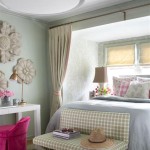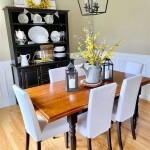Spring House Decor Ideas: Design Trends for 2025
As winter's chill fades and nature begins its vibrant rebirth, homeowners often seek to refresh their living spaces with the spirit of spring. Spring 2025 decor trends point towards a harmonious blend of nature-inspired elements, technological integration, and a renewed focus on sustainable practices. This article will explore the key design trends anticipated for Spring 2025, providing insight into bringing the season's freshness indoors.
Biophilic Design: Embracing Nature Indoors
Biophilic design, characterized by incorporating natural elements into the built environment, will continue to dominate Spring 2025 decor. This trend reflects a growing awareness of the positive impact of nature on well-being. The focus shifts beyond simply adding potted plants to actively integrating natural materials, light, and spatial arrangements that mimic natural patterns.
Materials: Expect to see increased use of natural materials such as bamboo, rattan, hemp, and reclaimed wood. These elements can be incorporated into furniture, flooring, and wall coverings. The texture of these materials brings warmth and a sense of grounding to a space.
Color Palette: The color palette draws inspiration from the natural world. Earthy tones like terracotta, ochre, and sage green provide a grounding base. These are complemented by brighter accents of floral hues such as lavender, daffodil yellow, and sky blue. These colors evoke feelings of freshness and renewal.
Lighting: Natural light is a crucial element of biophilic design. Maximize natural light exposure by using sheer curtains or leaving windows unobstructed. Strategic placement of mirrors can also help to reflect and amplify natural light throughout the room. For artificial lighting, opt for fixtures with warm tones and natural-looking diffusers to mimic the gentle glow of sunlight.
Plants and Greenery: Houseplants remain a cornerstone of spring decor. Focus on creating miniature indoor ecosystems with a variety of plants. Consider vertical gardens, hanging planters, and terrariums to add visual interest and purify the air. Integrating herbs into the kitchen decor provides both aesthetic appeal and functional benefits, aligning with the trend of sustainable living.
Water Features: Small water features, such as indoor fountains or tabletop waterfalls, introduce the calming sound of flowing water, further enhancing the connection with nature. These elements can create a serene and relaxing atmosphere, particularly beneficial for living rooms and bedrooms.
Smart Home Integration: Seamless Technology for Enhanced Living
Technology continues to play a significant role in home decor. In Spring 2025, the focus shifts towards seamless integration of smart home devices that enhance both functionality and aesthetics. The goal is to create a living space that is not only visually appealing but also responsive to the needs of the inhabitants.
Smart Lighting: Smart lighting systems allow homeowners to control the color and intensity of light based on mood and time of day. During spring, these systems can be programmed to mimic the natural progression of daylight, promoting natural sleep cycles and enhancing overall well-being. Voice-controlled or app-based systems provide ease of use and customization.
Automated Window Treatments: Automated blinds and curtains adjust to the position of the sun, optimizing natural light and reducing energy consumption. This feature is especially useful during the warmer months, helping to keep the home cool and comfortable. These systems can be integrated with smart home assistants for voice control and scheduled operation.
Smart Climate Control: Smart thermostats learn the homeowner's preferences and automatically adjust the temperature to maintain a comfortable environment. These systems can also be programmed to conserve energy when the home is unoccupied. Integration with weather forecasts allows for proactive temperature adjustments based on anticipated changes.
Integrated Entertainment Systems: Hidden or discreetly integrated entertainment systems minimize clutter and maintain the aesthetic appeal of the room. Televisions can be concealed behind artwork or mirrors, while speakers can be built into walls or ceilings. Voice-controlled systems allow for easy access to streaming services and music without the need for remote controls.
Smart Security Systems: Enhanced security systems feature integrated cameras, motion sensors, and automated door locks. These systems can be controlled remotely via smartphone, providing peace of mind and added security. The design of these systems prioritizes discreet integration, ensuring that they do not detract from the overall aesthetic of the home.
Sustainable and Ethical Decor: Conscious Consumption
Sustainability and ethical sourcing are no longer niche trends, but fundamental considerations in home decor. Spring 2025 will see a continued emphasis on conscious consumption, with homeowners actively seeking out eco-friendly and ethically produced products.
Upcycled and Repurposed Furniture: Upcycling and repurposing old furniture reduces waste and adds character to the home. Refinishing vintage pieces or transforming discarded materials into functional furniture are popular choices. This approach not only reduces environmental impact but also creates unique and personalized living spaces.
Eco-Friendly Materials: Prioritize materials with low environmental impact, such as bamboo, cork, recycled glass, and organic cotton. These materials are sustainable, durable, and aesthetically pleasing. Look for products that are certified by reputable organizations, such as the Forest Stewardship Council (FSC) or the Global Organic Textile Standard (GOTS).
Locally Sourced Products: Supporting local artisans and businesses reduces transportation emissions and supports the local economy. Seek out handcrafted furniture, textiles, and decorative items that are made in your region. This approach promotes community engagement and ensures that products are made with ethical labor practices.
Non-Toxic Finishes and Paints: Conventional paints and finishes often contain volatile organic compounds (VOCs) that can be harmful to human health and the environment. Opt for low-VOC or zero-VOC paints and finishes to reduce indoor air pollution. Natural finishes, such as beeswax and linseed oil, are also excellent alternatives.
Minimalist Design: Embracing a minimalist approach to decor reduces consumption and promotes a sense of calm and order. Focus on essential items and avoid unnecessary clutter. This approach not only simplifies the living space but also encourages mindful consumption habits.
Vintage and Antique Shopping: Shopping for vintage and antique items is a sustainable alternative to buying new products. Vintage pieces often have a unique charm and character that cannot be replicated with modern manufacturing techniques. This approach also helps to preserve cultural heritage and reduce the demand for new resources.
Responsible Disposal: When it is necessary to dispose of old furniture or decor items, consider donating them to charity or recycling them. Many organizations accept gently used furniture and household goods. Recycling programs can also help to divert materials from landfills.
In summary, Spring 2025 home decor trends highlight a convergence of nature, technology, and ethical considerations. Biophilic design brings the outdoors in, creating a calming and restorative environment. Smart home integration enhances convenience and energy efficiency. Sustainable and ethical practices prioritize environmental responsibility and conscious consumption. By embracing these trends, homeowners can create living spaces that are not only visually appealing but also aligned with their values and the needs of the planet.
The integration of these trends allows for a fluid and dynamic approach to interior design. A homeowner might choose to center a room around a large indoor tree, employing smart lighting to mimic sunrise and sunset patterns around it. The furniture surrounding the tree could be made from reclaimed wood, adorned with cushions made of organic cotton. Smart thermostats regulate the room's temperature, ensuring comfort while conserving energy. The curtains, made of natural linen, automatically adjust to maximize natural light, fostering an optimal environment for the plants and occupants alike. This scenario illustrates how these key trends can work in harmony, creating a space that is both beautiful and beneficial.
Ultimately, the Spring 2025 design trends aim to create homes that are not just aesthetically pleasing, but also contribute positively to the well-being of both people and the planet. The emphasis on natural materials, sustainable practices, and seamless technological integration points towards a future where homes are more connected to nature, more responsive to their inhabitants, and more environmentally responsible.

Designers Reveal The Top Spring Interior Design Trends Of 2025

Living Room Trends 2025 What S New In Home Comfort And Style Decorilla Interior Design

Designers Reveal The Top Spring Interior Design Trends Of 2025

13 Inspiring Spring Home Decor Trends For 2025 Bluesky At

Spring Makeover 50 Trendy And Affordable Decor Ideas For 2025 Elegance Echoes

Glamorous Spring 2025 Home Interior Design Trends Luxury Living Room Tv Wall Inspirations

10 Simple Spring Home Decor Ideas For 2025 Jane At
:max_bytes(150000):strip_icc()/StRegis037-b1d50385f2d24a53816ed7a309d98206.jpg?strip=all)
7 Spring Trends Designers Are Loving For 2025

H M Home S 2025 Minimalist Inspired Spring Collection

Spring Home Decor Trends And Design Ideas For 2025 Jane At
Related Posts







